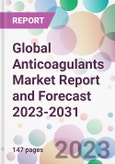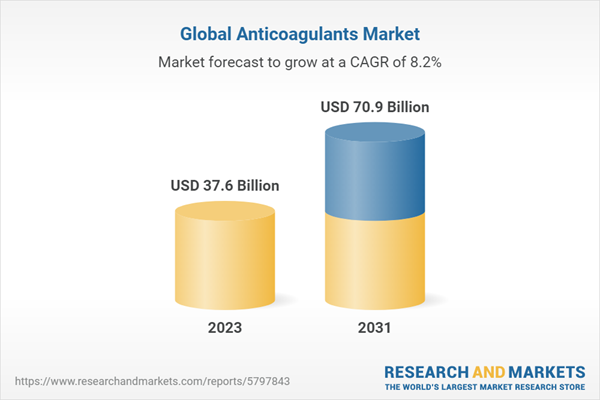The global anti coagulants market size attained a value of USD 34.8 billion in 2022. The market is anticipated to grow at a CAGR of 8.2% during the forecast period of 2023-2031 to attain a value of USD 70.9 billion by 2031.
Anticoagulants are commonly used to treat a variety of conditions, including deep vein thrombosis, pulmonary embolism, stroke, and heart attack. They are also used to prevent blood clots in individuals who are at high risk, such as those with a history of blood clots or those who are undergoing surgery.
The benefits of anticoagulants are numerous. By preventing the formation of blood clots, anticoagulants can help to reduce the risk of serious complications such as stroke and heart attack. They can also help to improve overall blood flow and reduce the risk of damage to the veins and arteries.
Anticoagulants can be prescribed in various forms, including oral medication and injectable medication. The choice of medication depends on the individual's condition, medical history, and other factors.
It is important to use anticoagulants safely and according to the instructions of a healthcare provider. Overuse or misuse of anticoagulants can lead to adverse side effects, including bleeding and bruising. Regular monitoring of blood tests is often required to ensure that the medication is working properly and to adjust the dosage if necessary.
Overall, anticoagulants are an important tool for preventing blood clots and reducing the risk of serious complications. When used safely and appropriately, they can provide significant benefits for individuals with a variety of conditions.
The market for anticoagulants is highly competitive, with many players offering a wide range of products to cater to the diverse needs of healthcare providers and patients. The market is segmented based on product type, application, distribution channel, and geography.
Based on product type, the market is divided into heparin, warfarin, novel oral anticoagulants (NOACs), and others. NOACs are the fastest-growing segment of the market, driven by their effectiveness in preventing and treating blood clots with fewer side effects compared to traditional anticoagulants such as heparin and warfarin.
Based on application, the market is divided into venous thromboembolism, atrial fibrillation, coronary artery disease, and others. Venous thromboembolism is the largest segment of the market, owing to the high prevalence of conditions such as deep vein thrombosis and pulmonary embolism.
Based on distribution channel, the market is divided into hospitals, clinics, retail pharmacies, and online pharmacies. Hospitals are the largest distribution channel segment of the market, owing to the high demand for anticoagulants in acute care settings.
The market for anticoagulants is expected to continue to grow in the coming years, driven by the increasing prevalence of conditions such as deep vein thrombosis, pulmonary embolism, stroke, and heart attack, as well as the growing demand for effective prevention and treatment options. Advances in technology and research are expected to lead to the development of new and innovative anticoagulant products, which may provide more effective options for patients suffering from blood clotting disorders.
Overall, the anticoagulants market is an important component of the healthcare system, providing patients with access to a wide range of prevention and treatment options for blood clotting disorders. When used safely and appropriately, anticoagulants can provide significant benefits for individuals with a variety of conditions.
Anticoagulants Market: Introduction
Anticoagulants are a type of medication used to prevent the formation of blood clots. They work by interfering with the blood clotting process, which can help to prevent dangerous blood clots from forming in the veins or arteries.Anticoagulants are commonly used to treat a variety of conditions, including deep vein thrombosis, pulmonary embolism, stroke, and heart attack. They are also used to prevent blood clots in individuals who are at high risk, such as those with a history of blood clots or those who are undergoing surgery.
The benefits of anticoagulants are numerous. By preventing the formation of blood clots, anticoagulants can help to reduce the risk of serious complications such as stroke and heart attack. They can also help to improve overall blood flow and reduce the risk of damage to the veins and arteries.
Anticoagulants can be prescribed in various forms, including oral medication and injectable medication. The choice of medication depends on the individual's condition, medical history, and other factors.
It is important to use anticoagulants safely and according to the instructions of a healthcare provider. Overuse or misuse of anticoagulants can lead to adverse side effects, including bleeding and bruising. Regular monitoring of blood tests is often required to ensure that the medication is working properly and to adjust the dosage if necessary.
Overall, anticoagulants are an important tool for preventing blood clots and reducing the risk of serious complications. When used safely and appropriately, they can provide significant benefits for individuals with a variety of conditions.
Anticoagulants Market Segmentations
The market can be categorised into drug class, application, route of administration, distribution channel, and region.Market Breakup by Drug Class
- Novel Oral Anticoagulants (NOACs)
- Heparin and Low Molecular Weight Heparin (LMWH)
- Vitamin K Antagonist
Market Breakup by Application
- Atrial Fibrillation/Myocardial Infarction (Heart Attack)
- Deep Vein Thrombosis (DVT)
- Pulmonary Embolism
- Others
Market Breakup by Route of Administration
- Oral Anticoagulants
- Injectable Anticoagulants
Market Breakup by Distribution Channel
- Oral Anticoagulants
- Injectable Anticoagulants
Anticoagulants Market Breakup by Region
North America
- United States of America
- Canada
Europe
- United Kingdom
- Germany
- France
- Italy
- Others
Asia Pacific
- China
- Japan
- India
- ASEAN
- Australia
- Others
Latin America
- Brazil
- Argentina
- Mexico
- Others
Middle East and Africa
- Saudi Arabia
- United Arab Emirates
- Nigeria
- South Africa
- Others
Anticoagulants Market Scenario
The global market for anticoagulants is expected to experience steady growth in the coming years, driven by the increasing prevalence of conditions such as deep vein thrombosis, pulmonary embolism, stroke, and heart attack, as well as the growing demand for effective prevention and treatment options.The market for anticoagulants is highly competitive, with many players offering a wide range of products to cater to the diverse needs of healthcare providers and patients. The market is segmented based on product type, application, distribution channel, and geography.
Based on product type, the market is divided into heparin, warfarin, novel oral anticoagulants (NOACs), and others. NOACs are the fastest-growing segment of the market, driven by their effectiveness in preventing and treating blood clots with fewer side effects compared to traditional anticoagulants such as heparin and warfarin.
Based on application, the market is divided into venous thromboembolism, atrial fibrillation, coronary artery disease, and others. Venous thromboembolism is the largest segment of the market, owing to the high prevalence of conditions such as deep vein thrombosis and pulmonary embolism.
Based on distribution channel, the market is divided into hospitals, clinics, retail pharmacies, and online pharmacies. Hospitals are the largest distribution channel segment of the market, owing to the high demand for anticoagulants in acute care settings.
The market for anticoagulants is expected to continue to grow in the coming years, driven by the increasing prevalence of conditions such as deep vein thrombosis, pulmonary embolism, stroke, and heart attack, as well as the growing demand for effective prevention and treatment options. Advances in technology and research are expected to lead to the development of new and innovative anticoagulant products, which may provide more effective options for patients suffering from blood clotting disorders.
Overall, the anticoagulants market is an important component of the healthcare system, providing patients with access to a wide range of prevention and treatment options for blood clotting disorders. When used safely and appropriately, anticoagulants can provide significant benefits for individuals with a variety of conditions.
Key Players in the Global Anticoagulants Market
The report gives an in-depth analysis of the key players involved in the anticoagulants market, sponsors manufacturing the drugs, and putting them through trials to get FDA approvals. The companies included in the market are as follows:- Johnson & Johnson Services, Inc
- Bayer AG
- Boehringer Ingelheim International GmbH
- Bristol-Myers Squibb Company
- Daiichi Sankyo Company, Limited
- GlaxoSmithKline plc
- Aspen Pharmacare Holdings Limited
- Pfizer Inc
- Portola Pharmaceuticals, Inc
- AstraZeneca
- Aspen Holdings
- Celgene
- Armetheon, Inc.
Table of Contents
1 Preface
3 Global Anticoagulants Market Overview
4 Global Anticoagulants Market Landscape
5 Global Anticoagulants Market Dynamics
6 Global Anticoagulants Market Segmentation
7 North America Anticoagulants Market
8 Europe Anticoagulants Market
9 Asia Pacific Anticoagulants Market
10 Latin America Anticoagulants Market
11 Middle East and Africa Anticoagulants Market
12 Patent Analysis
13 Grants Analysis
14 Funding Analysis
15 Partnership and Collaborations Analysis
16 Regulatory Framework
17 Supplier Landscape
18 Global Anticoagulants Market - Distribution Model (Additional Insight)
20 Company Competitiveness Analysis (Additional Insight)
21 Payment Methods (Additional Insight)
Companies Mentioned
- Johnson & Johnson Services, Inc.
- Bayer AG
- Boehringer Ingelheim International GmbH
- Bristol-Myers Squibb Company
- Daiichi Sankyo Company, Limited
- GlaxoSmithKline plc
- Aspen Pharmacare Holdings Limited
- Pfizer Inc.
- Portola Pharmaceuticals, Inc.
- Astrazeneca
- Aspen Holdings
- Celgene
- Armetheon, Inc.
Methodology

LOADING...
Table Information
| Report Attribute | Details |
|---|---|
| No. of Pages | 147 |
| Published | April 2023 |
| Forecast Period | 2023 - 2031 |
| Estimated Market Value ( USD | $ 37.6 Billion |
| Forecasted Market Value ( USD | $ 70.9 Billion |
| Compound Annual Growth Rate | 8.2% |
| Regions Covered | Global |
| No. of Companies Mentioned | 13 |









